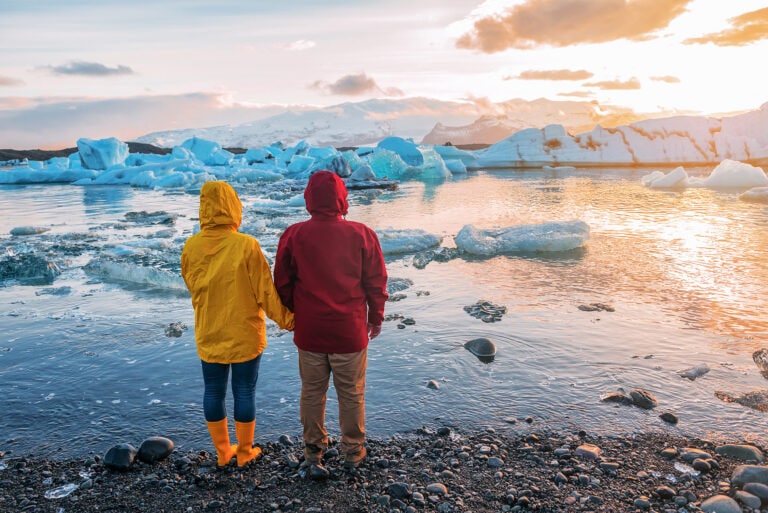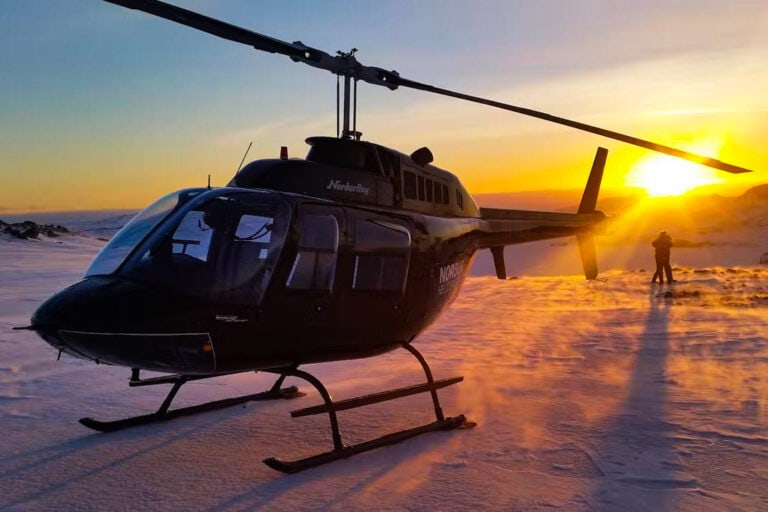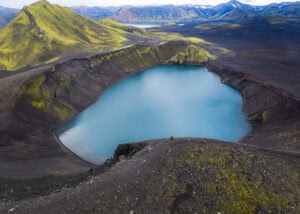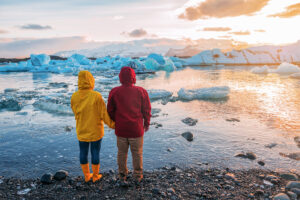Exploring Iceland always promises plenty of fun and adventures. If you don’t pack appropriately, however, you can be pretty cold! We’ll take you through the essentials to add to your packing list and give you lots of useful tips for how to dress in Iceland’s different seasons.
When thinking about what clothing to pack for your Icelandic vacation, it’s best to start by considering how the weather will be during your stay. Although you can never be 100% sure what the weather will be like on any particular day, you can definitely get a good idea by looking at average temperatures and common conditions for a certain season or time of year.

Layers on Layers
You’re probably already aware that dressing in layers is the best way to prepare for cold and changeable weather. You get more flexibility when it comes to regulating your body temperature and protecting yourself from the elements. Whatever the season, plan to dress in layers when traveling around Iceland. Plan for a minimum of three layers for each day. We’ll explain why …
The Base Layer: Moisture management
The first, or base layer refers to the clothes that lie directly against your skin (and over your actual underwear). The primary function of this underlayer is to let your skin breathe and keep you dry by wicking moisture away from your body. Garments should be made from soft and flexible materials that feel nice and are comfortable to wear.
While cotton may be great at letting your skin breathe, and is also usually comfortable, it actually absorbs moisture and takes a long time to dry. If it gets wet it will not only make you feel wet all day, but it will make you feel colder.
Ideally, the best fabric for base layers is merino wool. Popular with outdoor enthusiasts and hikers, merino wool dries fast and insulates your body. Alternatively, choose clothing made from other synthetic materials and designed with outdoor activities in mind.
The under layer should be close-fitting; think leggings and long-sleeved t-shirts. If visiting in summer, you may also want to carry a spare short-sleeved t-shirt in case it gets hot and sunny.
The Mid-Layer: Insulation
The second layer should insulate your body and help to prevent body heat from escaping. This ensures you stay warm when exploring the great outdoors. Insulating middle layers are available in various materials, with some better suited to different times of the year and specific activities.
Wool and polar fleece are common fabrics for the upper-middle layer. Indeed, locals typically wear knitted sweaters made from Icelandic wool. If you want to keep warm like an Icelander, buy a lopapeysa—a hand-knitted sweater with patterned shoulders and neck.
If it’s especially cold, you may consider wearing another insulation layer over the top, such as a jacket or vest made from down.
Quick-drying trousers are ideal for your bottom half. Alternatively, you could wear insulated shell pants.
Essentially, your middle layer, both top and bottom, should be breathable; it shouldn’t allow moisture to become trapped in between the layers.
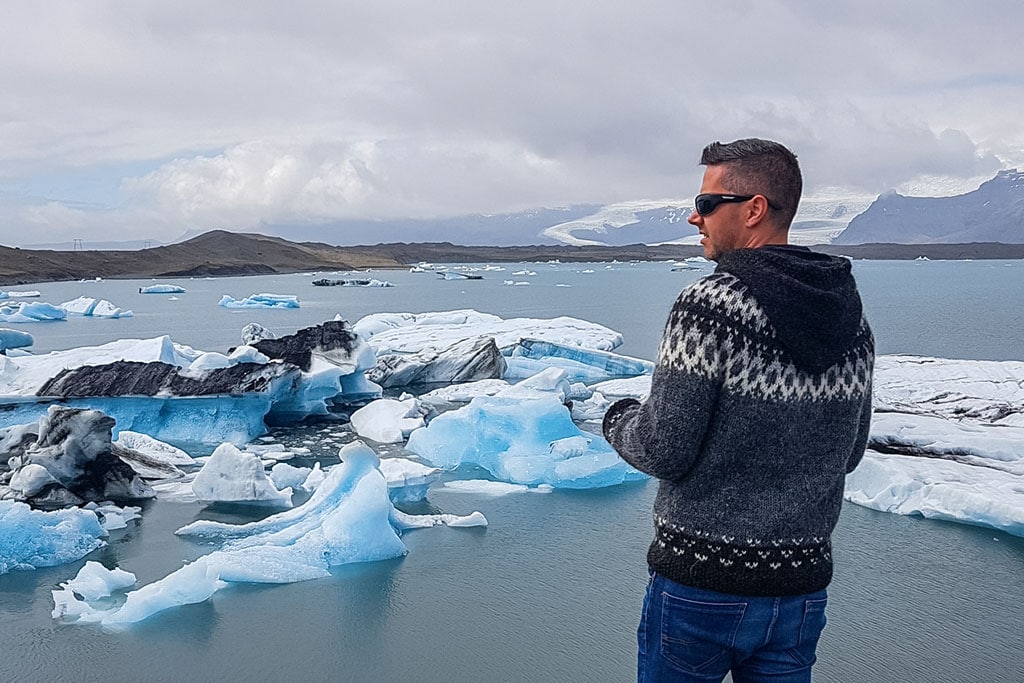
The Outer Layer: Rain and Wind Protection
Also known as the shell layer, the outer layer’s purpose is to offer protection from the elements. Rain and wind are both quite common in Iceland. You may experience wind and rain throughout the year, though the effects are different (because of air temperature and intensity) depending on the season.
At any time of year, however, being wet and cold can really spoil your trip! A good outer layer is essential.
Softshell is a great fabric for shell layer garments, as it is fast drying and protects you from the wind and rain. If your jacket isn’t waterproof, however, you’ll also need an additional rain jacket. In the winter, you can experience heavy rains. At all times you can also get pretty wet from the spray from waterfalls if standing close. We recommend that you have rain clothes at all times of the year when visiting Iceland.
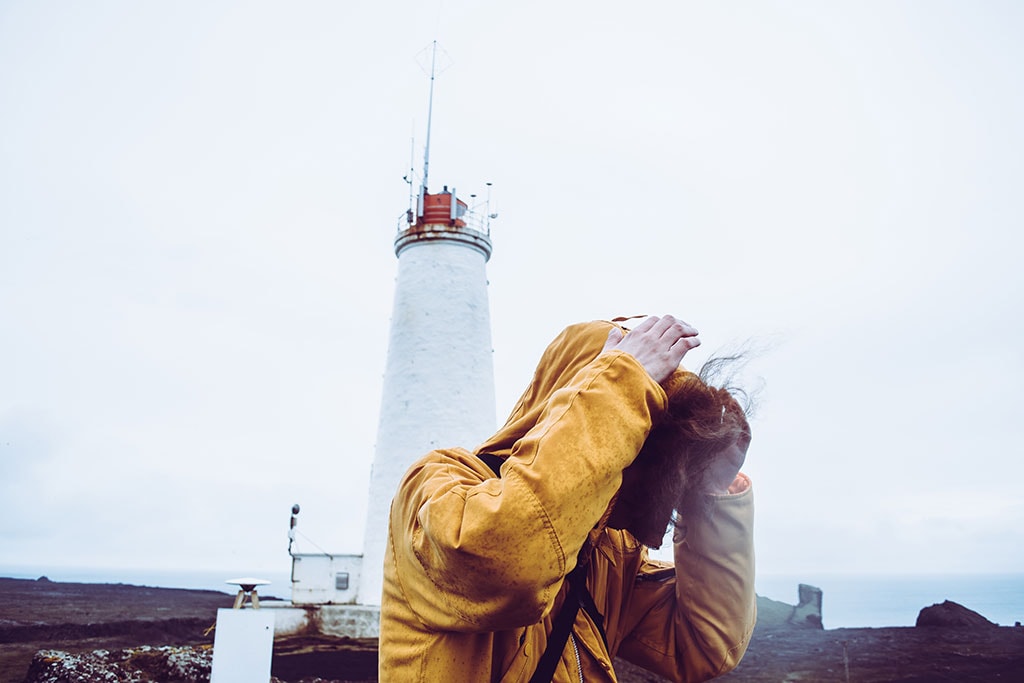
Other Important Accessories
Regarding footwear, many visitors to Iceland opt for sturdy boots to enjoy the outdoors. The ground can be muddy, wet, and uneven around natural attractions and along hiking trails. Good boots should be waterproof, comfortable, and provide good ankle support. Leather boots are ideal.
Regular trainers aren’t suitable options for much of Iceland’s terrain. And wearing high heels is generally a recipe for disaster!
When it’s windy in Iceland the temperature can feel much colder than it actually is. You may benefit from warming accessories, like a hat, scarf, gloves, and balaclava, even on chilly summer days.
How to Choose Your Clothing
Your traveling style also plays a part in the clothes you should pack for your Iceland trip. People who plan to spend lots of time outdoors, enjoying hiking, for example, will need to plan their outfits more than travelers who will spend large periods sitting inside a vehicle on a road trip.
Outdoor enthusiasts should consider the quality and suitability of their clothes. Good wind-proof and water-proof gear is essential due to being exposed to the elements a lot. Further, clothes should be breathable to cope with increased sweating that occurs through being more active.
People on a road trip will naturally focus more on comfort. They will need to add and remove outer layers throughout the day, when making stops, so easy-to-adjust layers are recommended.
If you’re planning to spend more time sightseeing in cities, you can be more relaxed with your wardrobe. You’ll still want comfortable shoes for walking around and probably a rain jacket in case of heavy rains. If you also want to enjoy natural attractions, such as day trips to waterfalls and beaches, sturdy walking boots and rainwear are important.
While locals generally won’t notice too much if you wear outdoor clothes to visit a low-key bar, it’s better to dress more stylishly when visiting restaurants, theatres, and other upmarket establishments. Check dress codes before visiting too to avoid disappointment.
Avoid standing out like a tourist when exploring Reykjavik by not donning your hiking gear for city explorations. Bring your regular day-to-day clothing from home that you’d typically wear to cultural events, restaurants, bars, etc. and you should be fine.
Locals typically dress pretty nicely when going for nights out. Think glamorous, hip, and vintage vibes. As with many other European cities, popular fashion houses include Zara, H&M, Lindex, and Reserved, while there are also popular Nordic brands, like Cintamani, 66North, and Farmer’s Market, where you can enjoy some retail therapy and add to your wardrobe.
Materials to Avoid
Denim garments, like jeans, and cotton clothing aren’t recommended for traveling in Iceland because of the fact that these materials get wet easily, hold water, and take a long time to dry. They can make you feel cold and wet for the entire day.
You should also steer clear of plastic raincoats if you want to stay comfortable. They can be difficult to adjust and leave you exposed to rain and wind. They generally aren’t breathable and you can quickly feel clammy and sweaty inside, with moisture trapped making you wet from the inside out. Plus, they are often not well designed in general..
Heavy clothing can weigh you down and feel uncomfortable and cumbersome. Aim fr lightweight protective gear for the best experience. You can always carry extra garments with you, but wearing too many layers of heavy clothing isn’t advised.
Packing Checklist for Winter (October–April)
For Road Trips and Short Hikes
- Long-sleeved undergarments
- A sweater (wool or fleece)
- A down jacket or vest
- A warm winter parka (waterproof and windproof)
- Waterproof boots
- Warm wool socks
- Snow spikes/ice grippers for your boots
- Insulated, water-repellent pants
- A warm, windproof hat, gloves, and scarf
- Sunglasses
- Pajamas / nightwear
For City Life, Optionally
- A set of city wear and footwear
- A set of fancy wear
For Enjoying Life
- A bathing suit and a towel
Practical Items for Winter
- Hand cream and lip balm
- A reusable water bottle
- Reusable pocket warmers
Packing Checklist for Summer (May–September)
For Road Trips and Short Hikes
- Long-sleeved undergarments
- A t-shirt
- A sweater (wool or fleece)
- A softshell jacket
- Waterproof boots
- Softshell pants
- Raincoat (and rain pants for longer walks)
- A thin beanie, gloves, and a buff
- Sunglasses
- Pajamas / nightwear
For City Life, Optionally
- A set of city wear and footwear
- A set of fancy wear
For Enjoying Life
- A bathing suit and a towel
Practical Items for Summer
- A mini bottle of sunscreen (30+)
- Hand cream and lip balm
- A reusable water bottle
Additional Accessories
Here are some more items we think can be really useful and add to your overall comfort when travelling around Iceland.
A Small Backpack
A small backpack is useful for carrying your day-to-day essentials, such as wallet, keys, camera, drink, and foldable rain jackets. You can easily carry a backpack when out exploring and keep your hands free, there’s a reduced risk of dropping your bag, and it’s easy to access.
Sunscreen
The Icelandic sun can be very strong and hot during the summer months, and it’s possible to get sunburned. Don’t underestimate the sun, particularly when you’re spending long days outside where there may be little shade. Pack (or buy there) a good sunscreen, ideally with an SPF of 30 or higher. You may also want to consider packing a cap or sunhat to provide extra protection to your face.
Sunglasses
Sunglasses can be handy at all times of the year when visiting Iceland. They can add to your comfort when sightseeing in the summer and provide greater visibility when driving, especially when the sun hangs low over the horizon in the evenings. Even in the winter the sun can create glare off the bright white snow.
Sleeping Mask
Many people find a sleeping mask helpful when travelling, whether it’s used on planes or in hotel rooms that don’t have black-out blinds. The long daylight hours over Iceland’s summer can disturb sleep patterns too. Starting around the end of April, early sunrises combined with late sunsets can really throw out your circadian rhythm. By late May, there is often bright sunshine all through the day and night, with the Midnight Sun lasting until August.
What You Won’t Need in Iceland
An Umbrella
While you might think an umbrella would be great for rainy days in Iceland, it’s not! You’ll probably notice that locals don’t use umbrellas; it’s often simply too windy for an umbrella to be effective. Save the space in your luggage and bring a high-quality raincoat instead of an umbrella.
Bug Repellent
You’ll almost certainly be delighted to hear that Iceland doesn’t have any mosquitoes! There’s such a low chance of being bitten by bugs that you don’t need to worry about packing insect repellents.
What To Do if You Forgot Something
Don’t worry if you forget to pack anything for your trip—there are many shops around Iceland where you can pick up anything you need. Plus, any clothes or accessories you buy in Iceland will be suitable for local conditions.
The capital city of Reykjavik offers all kinds of shopping. There are two major shopping centres in the city: Smaralind and Kringlan. Each is home to a wide selection of fashion shops selling an array of garments for all occasions.
If you’re looking for great outdoor wear, Cintamani, 66North, and Zo-On outlets can be found throughout the city. Fjallakoffinn is ideal for picking up mountain gear and Icewear is another good option. You’ll also find a Sport’s Direct in Reykjavik, perfect for casual city-cum-sports gear.


